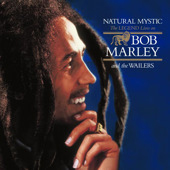SONGSEEDS - Three Chord Tricks
Conchordance
eBook :SONGSEEDS - Three Chord Tricks Conchordance is a systematic list of Three Chord Tricks that can be used as a reference book,song writing prompt or jamming tool. |
Paperbook Book :SONGSEEDS - Three Chord Tricks Conchordance is a systematic list of Three Chord Tricks that can be used as a reference book,song writing prompt or jamming tool. |
Bob Marley
|
|
Bob Marley is reggae music. |
|
So Much Trouble In The World
Concrete Jungle - Old Grey Whistle Test
Get Up Stand Up
Redemption Song
I Shot The Sheriff
Could You Be Loved
|
||
|
Gibson celebrated the late Bob Marley with a limited-edition Les Paul Special built to the exact specifications of his guitar on display at the Bob Marley Museum in Kingston, Jamaica (the original guitar is shown below).
|
|

MINOR SCALE THREE CHORD TRICKS WITH PHRYGIAN SECOND AND HARMONIC MINOR FIFTH SUBSTITUTIONS
As explained in BLOGoZON No. 85 every natural minor scale generates a predictable series of chords (built using a mixture of major and minor third intervals); with the simplest having 3 notes (triads) and the most complicated using all 7 notes of the major scale (thirteenths).
The simplest major scale, from a note naming point of view, is C major as it has ZERO sharp (♯) or flat (♭) notes. Similarly the A natural minor scale is the simplest minor scale (as it is really the C major scale re-ordered to start on A natural rather than C natural); a table of the scale follows:-
INTERVAL NUMBER |
||||||
1 |
2 |
♭3 |
4 |
5 |
♭6 |
♭7 |
NOTE NAMES |
||||||
A |
B |
C |
D |
E |
F |
G |
Using the 7 chords generated from the natural minor scale (Aeolian mode) there are a total of 35 chord progressions (when 3 chords are selected at one time) and these relationships have been tabulated for A minor to the right. As demonstrated by the table shown right each chord appears a total of 15 times (from a total of 35 chord progressions) The presence of the diminished chord produces a big problem from a pop music point of view (rather than jazz) as the sound of this chord is considered too difficult for most listeners. As the Bdim chord is contained in three-sevenths of the available chord progressions it leaves a limited number of usable 3 chord tricks (20 out of an original 35); hence an alternative chord is required to replace it. The solution to the replacement of the Bdim chord is arrived at by examining the complete minor scale harmony chart for all 15 key signatures (shown below) and identifying how many times an Am chord appears. |
|
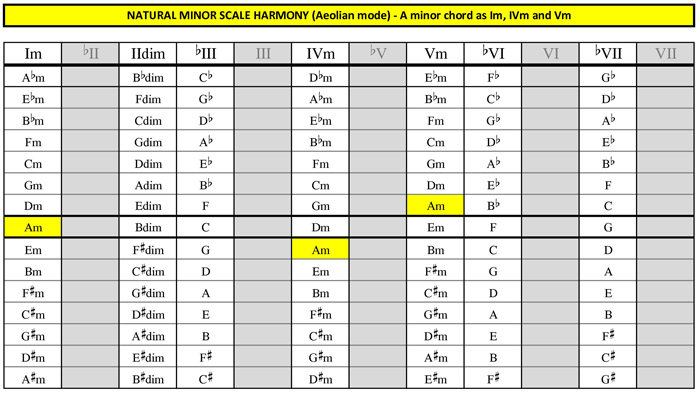
The Am chord appears a total of three times in the 15 available key signatures:-.
- as the Im chord in the key of A minor;
- as the IVm chord in the key of E minor;
- finally as the Vm chord in the key of D minor.
This produces two available solutions to the replacement of the Bdim chord in the 15 chord progressions where it makes an appearance (see above);this BLOGoZON examines the substitution chord produced where Am appears as the number IVm chord in the key of E minor.
The table that follows shows the natural minor scale generated harmony (3 note scale chords) for the keys of both A minor and E minor with the number IVm chord of E minor (Am) highlighted.

If the scale chords for the key of E minor are rearranged so that A minor is the starting chord this is known as the harmonized A dorian mode; which is tabulated below:-

Thus the IIm chord of the harmonized A dorian mode (B minor chord) can be used as a substitution (replacement) chord for the IIdim of the harmonized A minor scale (B diminished chord); as highlighted in the tables that follow:-

The table above can also be generated for all seven SHARP minor scales as defined by the CYCLE OF FIFTHS

Similarly the table can be produced for the FLAT minor scales as defined by the CYCLE OF FOURTHS
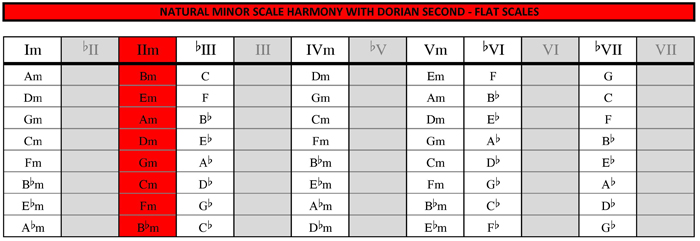
| Again using the 7 chords generated from the A minor scale (Aeolian mode) there are a total of 35 chord progressions (when 3 chords are selected at one time) and these relationships have been tabulated for a minor to the right. As previously demonstrated above each chord appears a total of 15 times (in the table shown right) and this now includes the substitution chord Bm. The problem sound created by the difficult Bdim chord has been solved by replacing it (substituting) with the Bm chord. As the Bdim chord was contained in three-sevenths of the available chord progressions it brings the number of usable 3 chord tricks back up to 35 (where Bdim represented 15 out of the original 35 chord progressions). |
|
To enhance the sound of a PERFECT CADENCE (V to I - Em to Am in the key of A minor) the number V chord is often replaced by a DOMINANT SEVENTH chord with the same root note ( i.e. in the key of A minor an E7 replaces the Em ).
This chord substitution is derived from the HARMONIC MINOR SCALE which differs from the natural minor scale by only one note.
In the natural minor scale the seventh note is a G natural - which produces the MINOR SEVENTH INTERVAL- whereas the harmonic minor scale has a G sharp note which generates the MAJOR SEVENTH INTERVAL.
The A harmonic minor scale can be tabulated as follows:-
INTERVAL NUMBER |
||||||
1 |
2 |
♭3 |
4 |
5 |
♭6 |
7 |
NOTE NAMES |
||||||
A |
B |
C |
D |
E |
F |
G♯ |
Harmonizing the A harmonic minor scale in thirds (i.e. start on each note in turn taking every other letter of the scale until 3 notes have been accumulated e.g. A, C, E – A minor; B, D, F – B diminished;
C, E, G♯ – C augmented; D, F, A – D minor; E, G♯, B - E major; F, A, C – F major; G♯, B, D – G♯ diminished) produces the following table:-
A HARMONIC MINOR SCALE HARMONY |
||||||
Im |
IIdim |
♭IIIaug |
IVm |
V |
♭VI |
VII |
Am |
Bdim |
Caug |
Dm |
E |
F |
G♯dim |
The substitution chord E major has been highlighted in the next table:-

The E major produced by the harmonic minor scale replaces the E minor in addition to the B minor (dorian second substitution) replacing the Bdim in the key of A minor as follows:-
![]()
The table above can also be generated for all seven SHARP minor scales as defined by the CYCLE OF FIFTHS
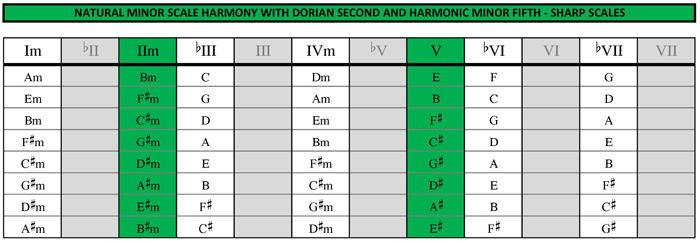
Similarly the table can be produced for the FLAT minor scales as defined by the CYCLE OF FOURTHS
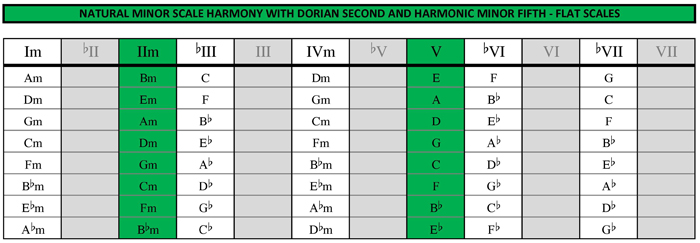
Substituting for both the Bdim and Em chords in the A natural minor series of scale chords produces a further 35 chord progressions (when 3 chords are selected at one time) and these relationships have been tabulated to the right. |
|
Every one of the 35 numerically ordered 3 CHORD TRICKS (progressions) can be re-ordered a further 6 times, which produces a total of 210 potential SONGSEEDS for each and every key signature. An example table follows for chord Progression No. 3, which has a generalised relationship of Im, IIm, V :-
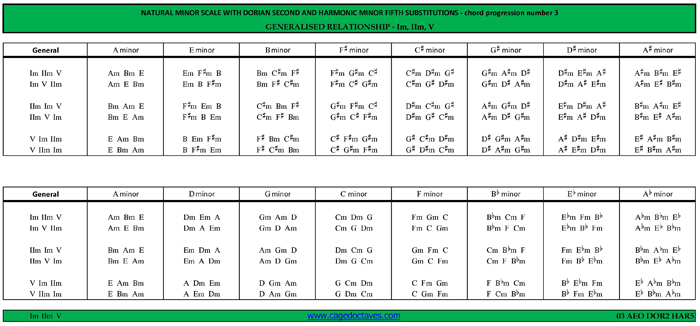
The question is "Has any of this music theory nonsense been used to write any decent songs that both sounded good and made some money for the writer?"
Fortunately the answer is a resounding YES and as Bob Marley is the subject of this weeks BLOGoZON the song in question is So Much Trouble In The World which utilises a 3-chord progression that involves a HARMONIC MINOR FIFTH SUBSTITUTION for the seconf half of the chorus chord sequence.
The song in question is taken from Marley's 1979 album Survival - the second half of the chorus uses a
Im, IVm, V7
(Am-Dm-E7) chord sequence.
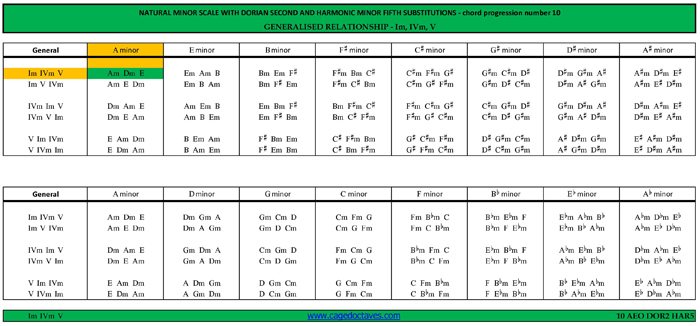
|
So you think you found the solution, |











